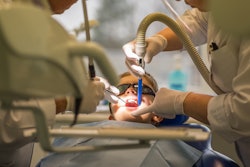Dr. Karen Man believes that parents can make Halloween a fun and healthy time for families.
 Dr. Karen Man.
Dr. Karen Man.
"With some simple adjustments and a focus on good oral hygiene, children can enjoy Halloween without any long-term impact on their dental health," Dr. Man said.
With that in mind, here are Dr. Man's eight tips on how to accomplish that goal.
Choose your candy wisely.
"Not all candies are created equal in their effects on teeth," Dr. Man explained. "The worst offenders are sticky, chewy, or sour candies. Candies like gummies, taffy, or caramels cling to teeth, making them difficult to remove, even with brushing. Sour candies are particularly harmful because they combine sugar with acid, eroding enamel faster."
If you have to satisfy your sweet tooth, Dr. Man recommends chocolates, particularly dark or semisweet varieties.
"Chocolate melts quickly and doesn't stick to teeth as much as other candies, making it a safer choice for your smile. Plus, dark chocolate tends to have less sugar than milk chocolate, which is an added bonus," she said.
Avoid prolonged snacking.
"One of the biggest risks to dental health during Halloween is not the candy itself but how long it is eaten," Dr. Man said. "Constant snacking throughout the day means continuous exposure to sugar, which provides a feast for cavity-causing bacteria. Instead, I advise parents to let their kids enjoy their candy in one go, perhaps after a meal, and then put the rest away. This way, the teeth are exposed to sugar for a shorter period, reducing the risk of cavities."
Don't stress over one night.
"Parents often worry about the sugar overload on Halloween night, but one night of indulging won't necessarily lead to cavities," Dr. Man stated. "The real issue is when sugar consumption continues unchecked for days or weeks afterward. Let your kids enjoy their Halloween night and then help them moderate their candy intake moving forward. Store excess candy out of reach and offer to trade it for other rewards, such as a fun outing or an extra bedtime story."
Drink plenty of water.
"Encourage children to drink water, especially after eating candy. Water helps wash away sugars and food particles, reducing the chance for bacteria to thrive. If you can, opt for fluoridated water, which can help strengthen teeth and protect against decay," Dr. Man advised.
Opt for noncandy treats.
"If you're handing out treats this Halloween, consider some fun, noncandy alternatives," Dr. Man suggested. "Stickers, small toys, or glow sticks are all great options that children enjoy without affecting their teeth. Offering these alternatives can help set an example for making healthier choices while still celebrating the fun of Halloween."
Timing matters: Enjoy candy during meals.
"When it comes to candy consumption, timing is key," Dr. Man said. "The best time to enjoy sweets is during or immediately after a meal. During meals, saliva production increases, which helps wash away food particles and neutralize the acid produced by bacteria. Letting children have their Halloween treats after a meal helps minimize the risk of cavities."
Candy buy-back programs for community involvement.
"At SmileGrove Dental, we're hosting a candy buy-back program this year. Programs like these are a fantastic way to reduce candy consumption and make it fun for kids. They can exchange their excess candy for a small reward or a healthier treat, and the clinic then donates to a charitable cause. This allows kids to participate in Halloween festivities while also learning about moderation and community contribution," Dr. Man said.
Reinforce good oral hygiene practices.
With increased sugar intake during Halloween, reinforcing proper oral hygiene practices becomes even more important. Dr. Man advises the following:
- Brush twice daily. "Make sure kids brush their teeth twice a day, especially before bed, using a fluoride toothpaste. Brushing at night is crucial because saliva production decreases during sleep, and sugar residue can do the most harm during this time."
-
Flossing is essential. "Sticky candies can get lodged between teeth where a toothbrush can't reach, so it's important to floss daily. Parents can help younger children floss to ensure all sugary bits are removed."
- Use sugar-free gum. "If brushing isn't possible immediately after eating candy, chewing sugar-free gum is a great alternative. It helps stimulate saliva production, which washes away sugar and neutralizes harmful acids. Xylitol-containing gum is particularly effective because it also helps fight cavity-causing bacteria."
Dr. Karen Man is a graduate of the University of Toronto in 2012. She practices at SmileGrove Dental in Oakville, Ontario. She is an active member of the Ontario Dental Association and the Canadian Dental Association.
The comments and observations expressed herein do not necessarily reflect the opinions of DrBicuspid.com, nor should they be construed as an endorsement or admonishment of any particular idea, vendor, or organization.



















